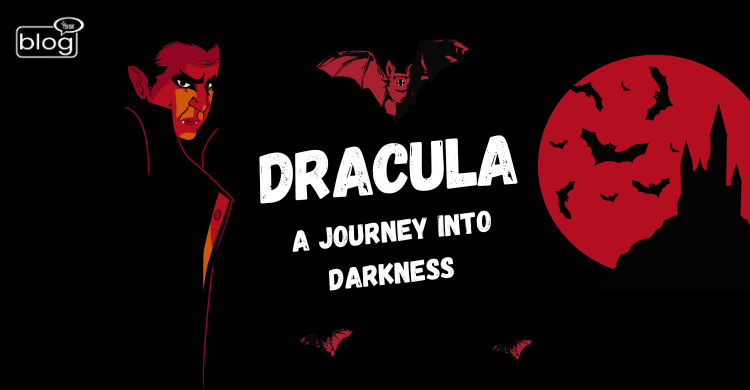Bram Stoker’s Dracula is one of those iconic, eternal novels that have been written in Gothic literature. First published in 1897, this novel about horror, romance, and the supernatural has left an indelible mark on pop culture to this day and continues to astound readers with the dark mystery of it all. At base, Dracula can be described as a good versus evil, love versus corruption, and unceasing quest for salvation against a powerful and otherworldly nemesis story.
The novel opens with a young solicitor, Jonathan Harker, traveling to the ominous Carpathian Mountains to complete the sale of a house in England to Count Dracula. Immediately, the opening chapters frame the tone of the novel, as Stoker vividly describes Dracula’s ominous castle and the sinister events within its walls. The terrible experiences of Harker with Dracula and the three vampire women send chills down the spine as the unending tension and the danger that pervade the novel start to unfold. Here, the Count’s premeditated manipulation of Harker and his eventual escape to England present Dracula as a master of terror and intrigue.
It is only when Dracula arrives in England that Stoker’s tale really gets underway, leaving a trail of chaos and terror in his wake. The doomed voyage of the ship Demeter to its arrival at Whitby is a lesson in atmospheric horror. The captain’s log, detailing the mysterious disappearance of his crew and the wolf-like creature leaping ashore, is one of the high points of the epistolary style of the novel as the terror mounts.
While Dracula is the antagonist of the novel and gives his name to the title, the real power in telling the story comes from an ensemble cast. The characters of Lucy Westenra, Mina Murray, Dr. John Seward, Professor Abraham Van Helsing, and others provide great depth and emotional resonance to the story. The sad metamorphosis of Lucy into a vampire and her final death are tragic and horrible simultaneously, reflecting Stoker’s skills in eliciting empathy for his characters and, at the same time sustaining an atmosphere of suspense.
In many ways, it is the character of Mina who is best described: as intelligent, courageous, and strong-spirited, with, more than anything, psychological developments due to Dracula’s psychic bonding with her. The other characters consist primarily of males around her the service and protection against Dracula led by the figure of Van Helsing. It comes across clearly through the development of loyalty in companionship that comradeship will play an increasingly powerful theme in this Victorian book concerning good ultimately conquering evil.
One of the things that most works for Dracula is its pacing. Stoker effortlessly segues from suspenseful set-pieces into moments of reflection, holding the reader’s interest continuously. From the chilling confrontation at Lucy’s tomb to the final chase across Eastern Europe, the novel sustains a captivating drive. The last fight in Dracula’s castle is at the same time exciting and sorrowful, as Quincey Morris sacrifices his life for the salvation of Mina’s soul. The bittersweet conclusion—with Dracula’s defeat and Mina’s release from her vampiric curse—is a satisfying end to the story’s central conflict.
The epistolary letters, journal entries, and newspaper clippings that Stoker used lend immediacy to the narration and multiple voices. This technique not only adds to the realism but also provides an insight into the thinking and emotions of the characters. Their struggles, victories, and losses become dear to the readers, and hence the emotional impact of the story is much more influential.
But beyond the thrilling plot, Dracula also concerns itself with age-old themes that readers today can understand: the tension between modernity and ancient superstition, the terror of the unknown, and the fragile nature of human life. In himself, Dracula is the embodiment of those fears: he is a physical as well as symbolic threat to Victorian society. His predatory nature, supernatural powers, and foreign origin tap into anxieties about the erosion of societal norms and the encroachment of the unfamiliar.
It is in the most poignant and atmospheric descriptions of Stoker that Dracula is not just a tale of horror but a masterpiece. In this novel, the scenery is so fully elaborated- from the dark Carpathian Mountains to the busy streets of London one fully expects danger lurking at every turn. The game of light and darkness, life and death, creates an almost beautiful background for the struggle of the characters.
Finally, Bram Stoker’s Dracula is something more than a Gothic novel of horror; it represents the dark depths of human fear and human desire. The entire gamut of rich characters, riveting narratives, and evocative themes promises its continuing success. Whether one is an avid reader of classics or merely beginning their adventure in this genre, this work remains truly obligatory and continues to frighten and inspire over a century after its creation.
To read more blogs like this click here
Writer
Fazlul Karim,
Intern, Content Writing Department
YSSE

